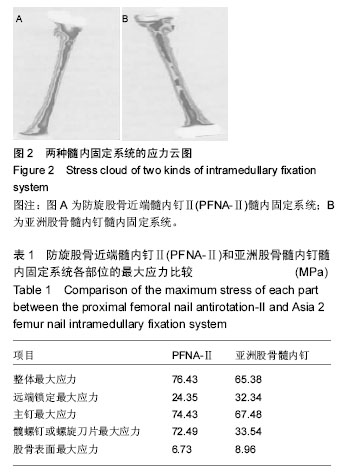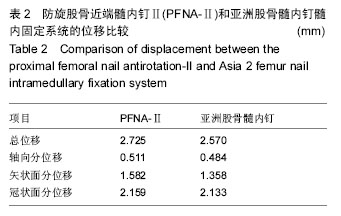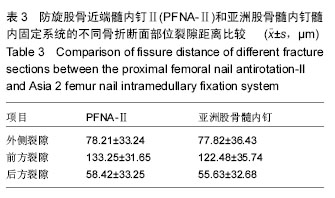| [1] Kini SG, Hin LC, Haniball J.Lateral cortex blowout during PFNA blade insertion in a subtrochanteric fracture---Should bone quality determine the type of nail used? Chin J Traumatol. 2015;18(2):116-119.
[2] Sun LJ, Wu ZP, Dai CQ,et al.A comparative study of less invasive stabilization system and titanium elastic nailing for subtrochanteric femur fractures in older children.Acta Orthop Belg. 2015;81(1):123-130.
[3] Zehir S, Zehir R, Sarak T.Early surgery is feasible in patients with hip fractures who are on clopidogrel therapy.Acta Orthop Traumatol Turc. 2015;49(3): 249-254.
[4] Keswani A, Lovy A, Khalid M,et al.The effect of aortic stenosis on elderly hip fracture outcomes: A case control study.Injury. 2015. pii: S0020-1383(15) 00617-8.
[5] Parker MJ.Hemiarthroplasty versus internal fixation for displaced intracapsular fractures of the hip in elderly men: a pilot randomised trial.Bone Joint J. 2015;97-B(7):992-996.
[6] Tosounidis TH, Lampropoulou-Adamidou K, Kanakaris NK.Intramedullary nailing of sequential bilateral atypical subtrochanteric fractures and the management of distal femoral intraoperative fracture.J Orthop Trauma. 2015.
[7] Iyengar KP, Matar HE, Nadkarni JB.Retrograde Intramedullary Nailing for Femoral Shaft Fractures in Elderly Patients with Previous Ipsilateral Dynamic Hip Screw Fixation.Gerontology. 2015;62(1):16-21.
[8] Kenan S, Gold A, Salai M,et al.Long-Term Outcomes Following Reduction and Fixation of Displaced Subcapital Hip Fractures in the Young Elderly.Isr Med Assoc J. 2015;17(6):341-345.
[9] Parker MJ, Pryor G, Gurusamy K. Hemiarthroplasty versus internal fixation for displaced intracapsular hip fractures: a long-term follow-up of a randomised trial. Injury. 2010;41(4):370-373.
[10] Liu P, Wu X, Shi H,et al.Intramedullary versus extramedullary fixation in the management of subtrochanteric femur fractures: a meta-analysis.Clin Interv Aging. 2015;10:803-811.
[11] Manohara R, Liang S, Huang D,et al.Cancellous screw fixation for undisplaced femoral neck fractures in the elderly.J Orthop Surg (Hong Kong). 2014;22(3): 282-286.
[12] Kini SG, Hin LC, Haniball J.Lateral cortex blowout during PFNA blade insertion in a subtrochanteric fracture---Should bone quality determine the type of nail used? Chin J Traumatol. 2015;18(2):116-119.
[13] Huang SG, Chen B, Zhang Y,et al.Comparison of the Clinical Effectiveness of PFNA, PFLCP, and DHS in Treatment of Unstable Intertrochanteric Femoral Fracture.Am J Ther. 2015.
[14] Makki D, Matar HE, Jacob N,et al.Comparison of the reconstruction trochanteric antigrade nail (TAN) with the proximal femoral nail antirotation (PFNA) in the management of reverse oblique intertrochanteric hip fractures. Injury. 2015;46(12):2389-2393.
[15] 陆建华,张小飞,马向阳,等.亚洲型股骨顺行髓内钉A2FN微创内固定治疗股骨干骨折[J].中国骨与关节损伤杂志, 2013,28(6):562-563.
[16] 吴广森,赵东升,黄爱文,等.Expert A2FN治疗成人股骨干骨折[J]. 医学研究杂志,2015,44(5):101-104.
[17] 胥少汀,葛宝丰,徐印坎,等.实用骨科学[M]. 4版.北京: 人民军医出版社,2012: 947-948.
[18] 陈孝平,石应康,邱贵兴,等.外科学[M].2 版.北京: 人民卫生出版社,2010: 958-959.
[19] 杜学忠,孙波,李瓦里.微创手术经皮加压钢板系统治疗股骨粗隆间骨折32 例体会[J].中国中医骨伤科杂志,2010, 18(3):20-21.
[20] 毕凤江.不同类型老年股骨粗隆间骨折治疗方法进展[J].中国中医药咨讯,2010,2(1):65.
[21] 张宇明,陈斌,常保国,等.动力髋螺钉与股骨近端抗旋髓内钉治疗转子间骨折的比较[J].中国组织工程研究,2012, 16(17) :3121-3125.
[22] 张功林,葛宝丰.股骨粗隆下骨折手术治疗进展[J].中国骨伤,2011,24(9): 791-793.
[23] 孙劲,喻爱喜. 股骨粗隆间骨折髓外内固定方法的进展[J].中国矫形外科杂志, 2011,19(2): 120-122.
[24] Kim JW,Oh CW,Byun YS, et al.A biomechanical analysis of locking plate fixation with minimally invasive plate osteosyn thesis in a subtrochanteric fracture model. J Trauma. 2011; 70(1): E19-23.
[25] Varela-Egocheaga JR,Lglesias-Colao R,Suarez-Suarez MA,et al.Minimally invasive osteosynthesis in stable trechanteric fractures: a comparative study between Gotfried percutaneous compression plate and Gamma 3 intramedullary nail.Arch Orthop Trauma Surg. 2009; 129(10): 1401-1407.
[26] 苏琦,杨新征,周敏,等.锁定钢板治疗股骨粗隆下骨折的临床分析[J].实用骨科杂志,2012,18(10):943-945.
[27] 李辉,彭阿钦.老年股骨转子间骨折术后隐性失血的分析[J].河北医药,2013,35(10):1505-1506.
[28] Guyver PM,McCarthv MJ,Jain NP,et al.The short-tenn functional and radiological outcome of palienls treated with the synthes proximal femoral nail antirutation (PFNA) for unstable pmximal femoral fractures. Eur J Orthop surg Tramumatol. 2011; 21(7): 493-501.
[29] 钱忠来,徐耀增,王现彬,等.动力髋螺钉、股骨近端防旋髓内钉和第3代Gamma钉置入内固定后生物力学性能与临床效果的比较[J].中国组织工程研究与临床康复,2010, 14(48):8974-8979.
[30] 杨晓建.PFN-A 治疗老年骨质疏松性股骨粗隆间骨折82 例[J].中国老年学杂志,2012,32(19):4431-4432.
[31] 张寿,孔长庚.人工关节置换与锁定钢板治疗老年女性不稳定粗隆间骨折的疗效比较[J].中国老年学杂志,2012, 32(19):4157-4159.
[32] Kempf I,Grosse A,Taglang G,et al.Gamma nail in the treatment of closed trochanteric fractures.Results and indications of 121cases.Orthop Traumatol Surg Res. 2014;100(1):75-83.
[33] Iwakura T,Niikura T,Lee SY,et al.Breakage of a third generation gamma nail: a case report and review of the literature.Case Rep Orthop. 2013;2013: 172352.
[34] 钱明权,朱国兴,陈刚.动力髋螺钉联合防旋阻挡钉与股骨近端髓内钉治疗不稳定型股骨粗隆间骨折的对比研究[J].中国矫形外科杂志,2013,21(10):957-962.
[35] Haq RU,Manhas V,Pankaj A,et al.Proximal femoral nails compared with reverse distal femoral locking plates in intertrochanteric fractures with a compromised lateral wall; a randomised controlled trial. Int Orthop. 2014;38(7):1443-1449.
[36] Korkmaz MF,Erdem MN, Disli Z,et al.Outcomes of trochanteric femoral fractures treated with proximal femoral nail:an analysis of 100 consecutive cases. Clin Interv Aging. 2014;9: 569-574.
[37] Calderón A,Ramos T,Vilchez F,et al.Proximal femoral intramedullary nail versus DHS plate for the treatment of intertrochanteric fractures.A prospective analysis. Acta Ortop Mex. 2013;27(4): 236-239.
[38] 黄诚,付聪聪,黄相杰.DHS和PFNA治疗老年骨质疏松性转子间骨折的临床疗效对比[J].中国矫形外科杂志,2014, 22(6):568-570.
[39] Yuan X,Yao Q,Ni J,et al.Proximal femoral nail antirotation versus dynamic hip screw for intertrochanteric fracture in elders: a metaanalysis. Zhonghua Yi Xue Za Zhi. 2014;94(11): 836-839.
[40] Nikoloski AN,Osbrough AL,Yates PJ.Should the tip-apex distance(TAD)rule be modified for the proximal femoral nail antirotation(PFNA)A retrospective study.J Orthop Surg Res. 2013; 8: 35. |
.jpg)



.jpg)
.jpg)